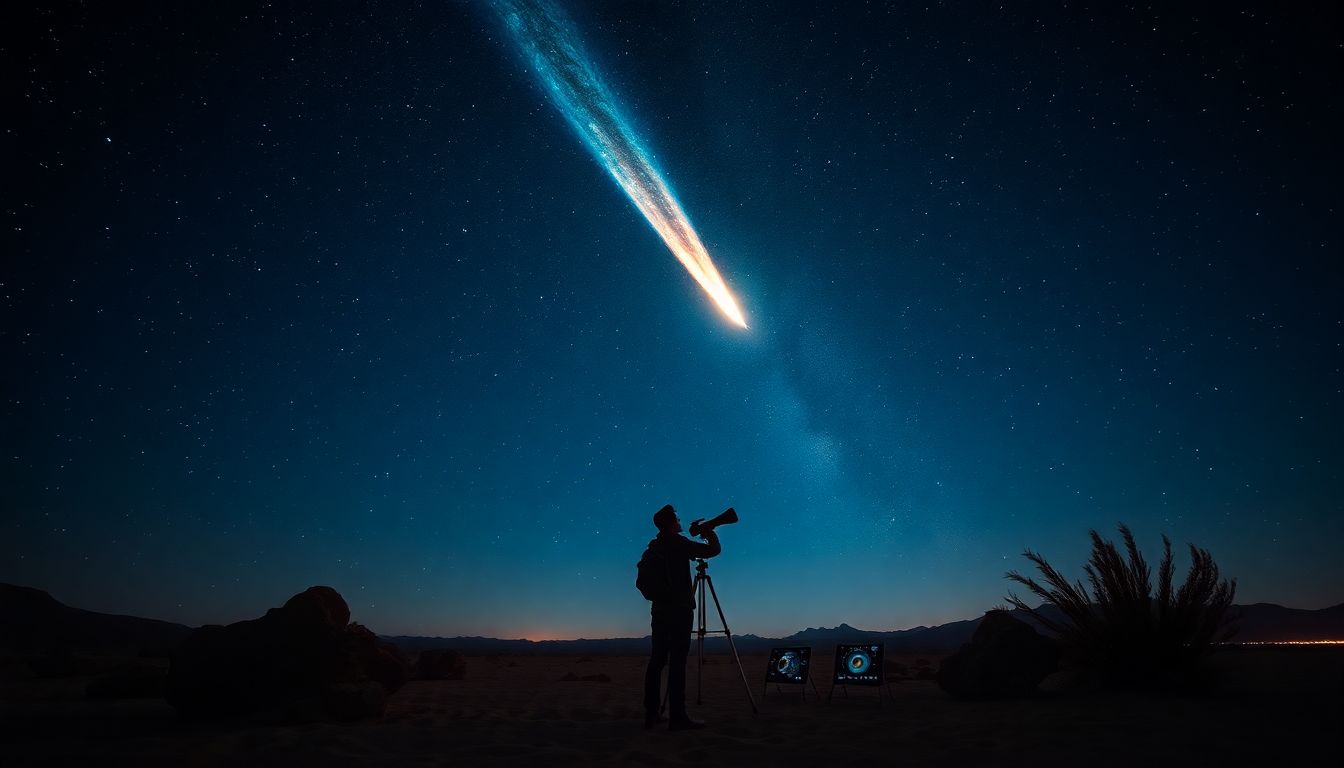
How to Check if There’s a Comet Right Now: A Complete Guide for Skywatchers
Introduction
Lots of people dream about catching a glimpse of a comet. These cosmic travelers are rare in our night sky, making each sighting special. Want to know if a comet is visible tonight? Staying updated with accurate info can turn an ordinary night into a once-in-a-lifetime experience. But spotting comets isn’t always easy; they can be elusive, hiding in the darkness. Luckily, there are simple ways to find out if a comet is lighting up the sky right now—and this guide will show you how.
Understanding Comets: What You Need to Know
What is a Comet?
Think of a comet as a giant snowball made of ice, dust, and gases. It orbits the Sun in a long, stretched-out path. When it gets close to the Sun, the heat causes it to glow, forming a bright nucleus, a fuzzy cloud called the coma, and a tail that streams behind it. The tail always points away from the Sun, creating a stunning picture if you catch it at the right moment.
Why Comets Are Visible Sometimes and Not Others
Comets are only visible when they’re close enough to Earth and the Sun to reflect light strongly. Their orbits are so long that they only come near us every few years or even centuries. The key factors that determine if you can see a comet include the comet’s distance from Earth, the Sun’s position, and how bright the comet is. Some comets appear brightly for just a few nights, while others stay visible longer or stay hidden altogether.
Famous Comets in Recent History
Remember Hale-Bopp in 1997? Or NEOWISE in 2020? These comets lit up the sky, becoming some of the most memorable sights for skywatchers. Each of these events was a lucky chance to see a rare visitor. Learning about past comets helps us understand when the next big one might arrive.
How to Find Out If a Comet Is Visible Now
Using Official Space Agency and Astronomy Websites
Start with trusted sources for comet updates. NASA and ESA websites often publish alerts when a new comet lights up the sky. They have dedicated pages tracking these events. Astronomy sites like Sky & Telescope and the European Space Agency’s space weather portal also offer real-time updates. Many websites even feature interactive maps showing where comets are currently visible.
Monitoring Skywatching Apps and Software
Smartphone apps make tracking comets easy. Popular options include Star Walk, Sky Guide, and Stellarium. These apps have live tracking features that show where a comet is right now. They also send notifications about upcoming comet appearances and display visibility maps based on your location. These tools turn your phone into a personal telescope guide.
Consulting Space Observation Satellites and Telescopes
Satellites like SOHO (Solar and Heliospheric Observatory) often spot comets near the Sun that are too faint for the naked eye. Many of these observations are available to the public. By browsing satellite data or astronomy databases, you can discover if any new comets are making their way toward Earth or the Sun.
Recognizing the Best Conditions to Observe a Comet
Optimal Viewing Times
The best time to see a comet depends on its position. Dusk or dawn can provide ideal conditions for some comets, especially if they’re close to the horizon. For others, late at night—when the sky is darkest—is better. Check the predicted times for the comet’s peak brightness so you don’t miss it.
Ideal Sky Conditions
Dark skies are essential for spotting dim objects like comets. Light pollution from cities can hide even bright comets. If possible, go to a rural area or a high viewpoint with clear, stable weather. Clouds and wind can block your view, so always check the forecast before heading out.
Equipment Needed for Observation
While some comets can be seen with the naked eye, binoculars often make viewing clearer. Small telescopes help you see more detail, like the tail or nucleus. Using star maps and apps can help locate the comet in the sky. Plus, filters can enhance contrast, making faint features more visible.
Staying Updated with Real-Time Comet Alerts
Subscribing to Astronomy Newsletters and Alerts
Many astronomy clubs and websites send out emails about upcoming celestial events. Subscribe to newsletters from Sky & Telescope or NASA’s space weather alerts. Setting up email or app alerts ensures you won’t miss the moment a new comet appears.
Joining Astronomy Communities and Forums
Online groups like Reddit’s r/astronomy or forums like Cloudy Nights are filled with enthusiasts sharing live updates and tips. Members often post photos, sightings, and location suggestions. Being part of these communities boosts your chances of discovering a comet’s latest activity.
Following Social Media and Official Space Agency Accounts
Twitter accounts from NASA, ESA, and well-known astronomers are active sources of real-time news. Use hashtags like #comet, #skywatching, or #astronomy to find the latest updates. Quick social media checks can alert you about sudden visible comets.
Tips for a Successful Comet Watching Experience
- Plan ahead based on known visibility peaks. Knowing when to look saves frustration.
- Pick a spot away from city lights. Dark skies improve your view significantly.
- Dress warmly and bring snacks if you plan to stay outside late.
- Always prioritize safety during night outings—bring someone with you.
- Capture photos or sketch the comet. It’s rewarding and helps you remember the event.
Conclusion
Finding out if a comet is visible tonight is easier than you think. Use trusted websites, apps, and community sources for updates. Observe under the best sky conditions, and be ready at the right time. Every comet sighting is a peek into the universe’s secrets, so stay curious, keep checking, and prepare to enjoy a spectacular show in the sky. Your next celestial surprise might be just a check away.

